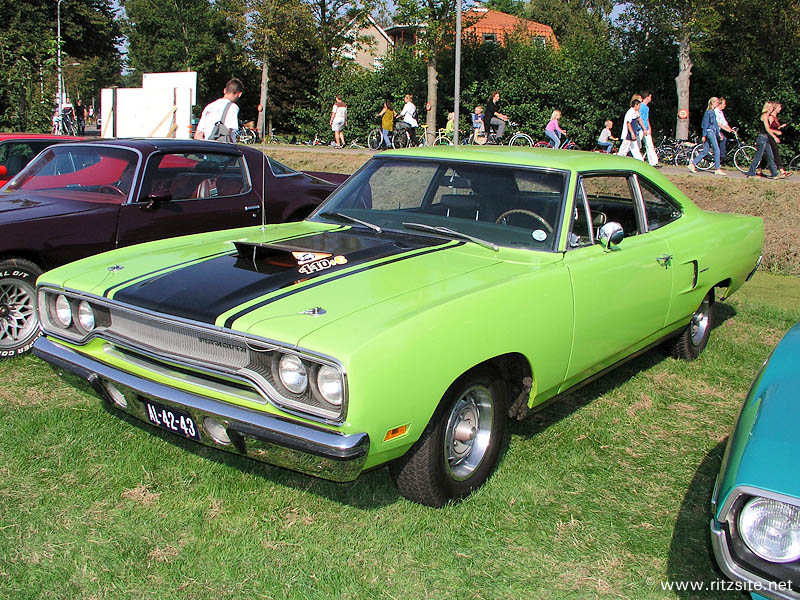|

Plymouth Road Runner 440+6 - 2-pillar coupe body - model year 1970
The perception of exciting, affordable, street legal sports and competition cars differs greatly between Europe and the USA. Where European manufacturers and tuners search for more performance and speed by applying lightweight constructions and high-revving engines with large power to displacement ratios, their American counterparts usually choose to fit huge, oversized engines and potent running gear in standard body shells. Both ways have their own merits; when looking for jet-like acceleration and excessive speed thrills in straight lines you can't beat the American muscle cars. A remarkable example of that is this Plymouth Road Runner.
The muscle-car craze was at its peak in the mid-1960s in America. Each manufacturer offered a number of models which featured lightning fast sprint abilities, staggering power output and huge displacement. Started as a factory produced alternative to a custom built hot rod, the muscle car was gradually transformed into an expensive and luxurious status symbol. In an effort to return back to basics the Chrysler concern introduced the Plymouth Road Runner and the Dodge Super Bee in 1968, meant to offer a maximum of excitement at a modest price, and had a best-seller.
The Plymouth became far more popular than the Dodge thanks to a neat marketing trick: the association with a popular and rebellious cartoon character of Warner Brothers, a small running bird which always outruns and outsmarts a hungry coyote. Naming the car after this character and featuring it in ads (and often on the cars itself) as a logo gave it a cult appeal which was hard to match. In contrast to the model name the hardware was very serious: as standard it offered a 383 cid (6.3 litre) V8 with 335 hp and it had the famed 426 cid (7 litre) "Hemi" V8 as an option, producing 425 hp and good for a quarter mile (0.4 km) sprint in under 13 seconds.
1969 saw the introduction of the additional 440 cid (7.2 litre) V8 engine option, available with a four barrel carb or three double barrel carbs. The latter was known as the 440+6 or 6BBL and gave the car an acceleration similar to the 426 Hemi, but was considerably cheaper to buy. Also a (unpopular) convertible version was introduced next to the pillared and hardtop coupe versions. This year proved to be the most successful for the Road Runner with 84,510 of them sold.
1970 was the last year for the Road Runner in original form. Raised insurance rates carved into the car's popularity and sales dropped to 41,484 cars. The engine choices remained similar to the previous year; the 440+6 was improved slightly though its original aluminum Edelbrock intake manifold was now replaced with a more regular cast iron unit. Most notable for the 1970 models, and shown on the picture above, was the optional retractable "Air Grabber" hood scoop. Normally closed and flush with the surface of the hood it could be raised with a switch on the dashboard, letting extra air into the air cleaner. When the engine was switched off the scoop closed automatically to seal the engine compartment. The 440+6 produced 390 hp @ 4700 rpm and an impressive 664 Nm torque @ 3200 rpm. Of the 2,531 manufactured 440+6 Road Runners in this model year just 651 had the pillared coupe body featured here (and there were only 34 convertibles); rarest was however the 426 Hemi version which sold a mere 212 times.
From 1971 on the true muscle car nature of the Road Runner was diluted year by year. The Road Runner name appeared on Plymouth cars until 1980, though 1974 is generally regarded as the last year for it being a muscle car (from 1976 it was mostly a trim package option for the Volare).
Many Plymouth Road Runners have survived to this day and these cars enjoy a strong popularity among enthusiasts. Its unique cartoon character image combined with serious street credibility ensures a lasting place in the hearts of muscle car fans, even if they weren't even born at the height of its production life. The 1968-1970 models are the ones to go for, especially the ones with the bigger engines. In Europe the Road Runner is relatively rare to find but makes a more original choice than, let's say, the Dodge Charger for the Mopar enthusiast.
You can find more information on the Road Runner and many more muscle cars at Musclecarclub.com.
© André Ritzinger, Amsterdam, Holland
|
